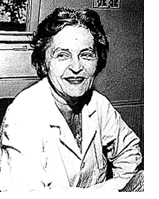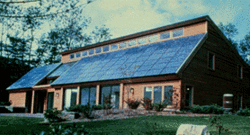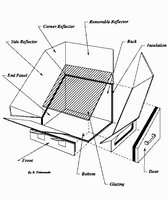Telkes, Maria (Energy)
Telkes, Maria
Maria Telkes (Dec. 12, 1900 – Dec. 2, 1995), a Hungarian-American physical chemist, designed the first residential solar heating system and invented many patented solar-powered devices. She became known as the “Sun Queen” during her career due to her many inventions including one of the first successful solar ovens, solar heating systems, and a solar water distilling system for making seawater potable.
Born in Budapest, Hungary, she entered the University of Budapest where she completed a B.A. in physical chemistry in 1920, followed by a Ph.D. in the same subject in 1924. Immigrating to the United States in 1925, she began working as a biophysicist for the Cleveland Clinic Foundation where her research related to life-transformative energy. In 1939, Telkes took a position in solar energy research and development at the Massachusetts Institute of Technology (MIT), and became an Associate Research Professor in 1945 in the field of metallurgy. It was during her time at MIT that she became widely known for her research in solar energy.
In 1948, while still working with MIT, Telkes designed the heating system for an experimental solar-heated house in Dover, Massachusetts, one which is still in use today. The house was meant to showcase the power of solar energy and was sponsored by Amelia Peabody, a wealthy Boston sculptor, and designed by the architect Eleanor Raymond. The heating system captured and stored solar energy chemically through the crystallization of a sodium sulfate solution and then distributed the heat by fans as needed. When public interest in solar energy grew due to the oil shock in the 1970s, Telkes participated in a joint effort between MIT and the U.S. Department of Energy to build her second house, the Carlisle Solar House in Massachusetts, in 1980.
In 1953, Telkes received a $45,000 grant from the Ford Foundation to work on the development of a solar oven. The goal of the grant was to develop a solar oven which would allow preparation of any national cuisine, by individuals of any country of the world, safe enough to be used by children, free the cook from constant stirring, and one that would not scorch foods. In the process of researching the oven, she developed a faster way for farmers to dry their crops.
In the same year, she moved to the New York University College of Engineering where she established a laboratory dedicated to solar energy research. From there she returned to industry, joining the Curtiss-Wright Company as Director of the firm’s solar energy laboratory. She moved on to Cryo-Therm, working on space- and sea-proof materials from 1961 to 1963 before moving on to Melpar, Inc., where she served as Director of the company’s solar energy laboratory until 1969. At that time, Telkes returned to academia as a researcher at the University of Delaware’s Institute of Energy Conversion.
During World War II, as a civilian advisor to the U.S. Office of Scientific Research and Development (OSRD), she designed a distilling system which used solar heat to convert seawater into drinking water. The device removed the salt from seawater by vaporizing it and recooling it into potable water. The system design was scalable, able to supply a small lift raft or an entire city with fresh water. Telkes received a certificate from OSRD for the invention.
Further Reading
- Maria Telkes (Virginia Tech Website}
- Women in Science
- Lemelson-MIT Program


